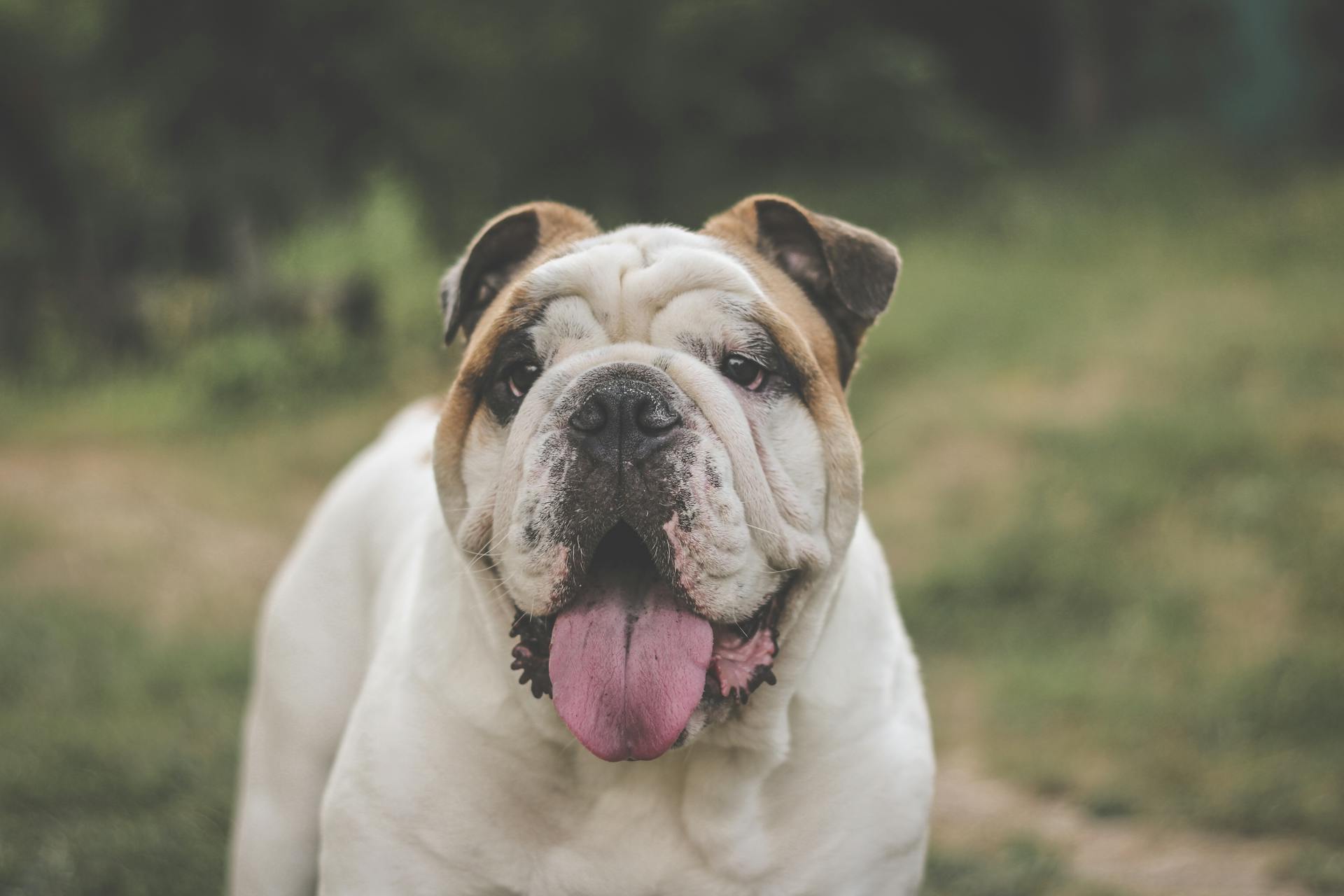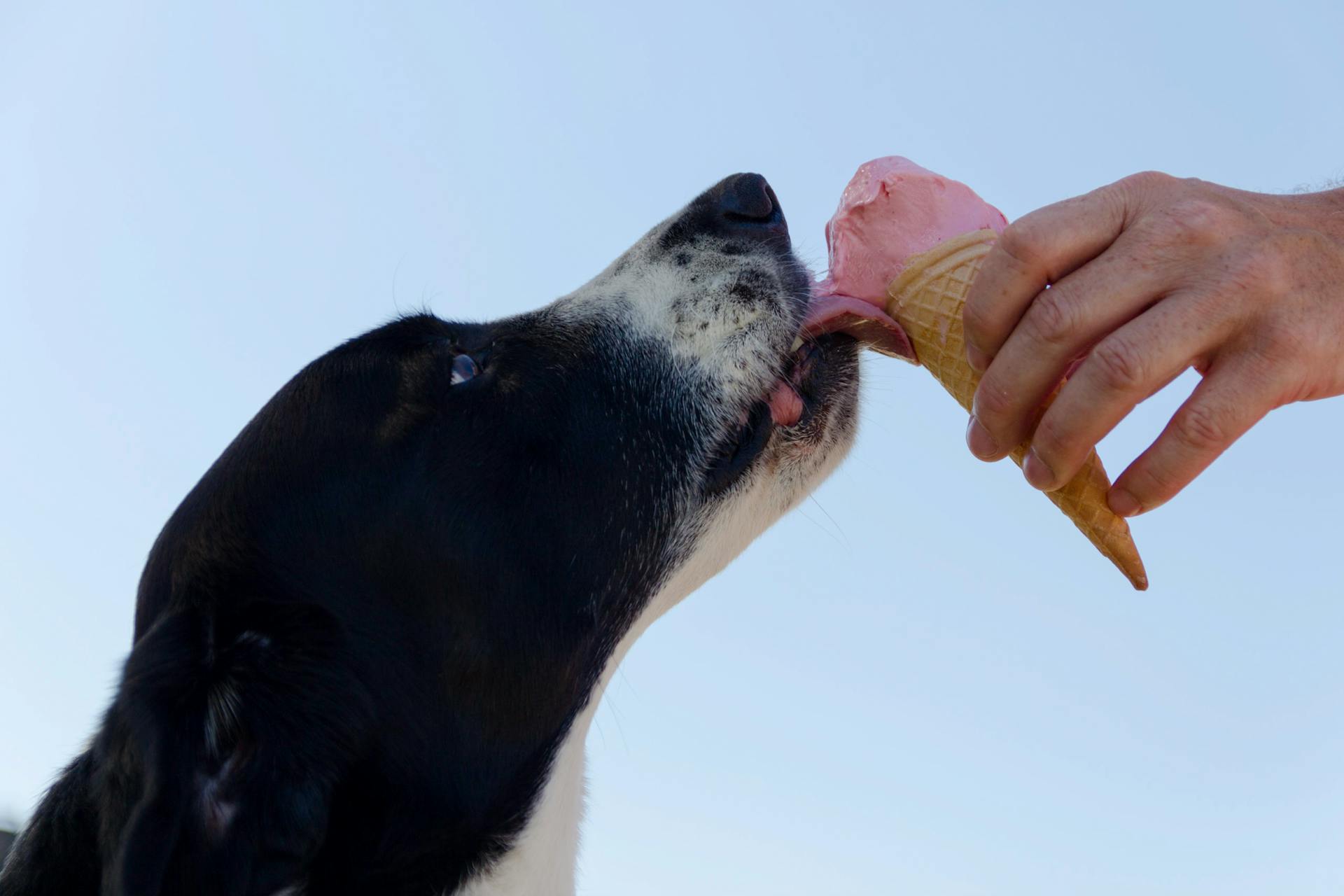
English Bulldogs are prone to breathing problems due to their unique physical characteristics, such as a flat face and short nasal passages.
Their brachycephalic skull structure can cause their airways to be narrowed, leading to difficulty breathing.
This can be especially problematic for English Bulldogs during hot weather or when they're exerting themselves physically.
English Bulldogs can also experience breathing difficulties due to their excessive skin folds, which can trap heat and moisture, further exacerbating breathing issues.
English Bulldog Breathing Problems
English bulldogs are prone to breathing problems due to their brachycephalic airway syndrome. This condition can lead to changes in the lungs and gastrointestinal tract, including bronchial collapse and gastroesophageal reflux.
Almost 55% of English bulldogs suffer from breathing issues, making it a common health problem in the breed. Many dogs also need surgery to fix the elongated palate, which causes snoring, wheezing, and difficulty breathing.
The severity of breathing difficulties can vary depending on the extent of the anatomical variations of the skull bones. In some cases, the symptoms may worsen as the dog ages.
Breathing troubles are just one of the many health issues English bulldogs are prone to, with the breed being twice as likely to develop major health problems compared to other breeds. This includes skin conditions, which can be a significant concern for dog owners.
Broaden your view: Common English Bulldog Health Issues
Health Issues and Concerns
English bulldogs are prone to various health issues, particularly breathing problems, due to their flat face and short snout. Almost 55% of English bulldogs suffer from breathing issues, making it crucial to be aware of the potential health risks.
The Royal Veterinary College has noted that English bulldogs are twice as likely to develop major health issues like breathing troubles and skin conditions compared to other dog breeds. This is largely due to the breed's brachycephalic (short-nosed) skull structure, which can lead to an elongated soft palate, stenotic nares, and other respiratory tract abnormalities.
Some common symptoms of breathing difficulties in dogs include visible movement of the chest and stomach during breath, flared nostrils, open-mouthed breathing, and noisy breathing. If you notice any of these symptoms in your English bulldog, it's essential to seek veterinary attention immediately.
The underlying causes of brachycephalic airway syndrome (BOAS) include stenotic nares, elongated soft palate, everted laryngeal saccules, and hypoplastic trachea. These anatomical abnormalities can obstruct airflow, leading to breathing difficulties and other health issues.
Expand your knowledge: English Bulldog Soft Palate Surgery
Here are some potential complications associated with BOAS:
- Laryngeal collapse
- Bronchial collapse
- Gastroesophageal reflux
- Chronic gastritis
- Aspiration pneumonia
It's essential to work with a reputable breeder who prioritizes the breed's health and avoids extreme conformation. Regular veterinary check-ups and a healthy lifestyle can also help mitigate the risks associated with BOAS.
If your English bulldog is diagnosed with BOAS, surgery may be necessary to correct the underlying anatomical abnormalities. Your veterinarian may recommend pre-anesthetic blood work and chest X-rays to evaluate your dog's general health before surgery.
In the meantime, managing your dog's weight, controlling exercise levels, and avoiding hot or humid conditions can help alleviate symptoms. Corticosteroids, NSAIDs, and oxygen therapy may also provide short-term relief. However, medical management does not correct the underlying anatomical abnormalities, and surgery is often the most effective treatment.
For another approach, see: English Bulldog Cherry Eye Surgery Cost
Boas Syndrome
Brachycephalic Obstructive Airway Syndrome (BOAS) is a common breathing problem in English Bulldogs. It's caused by a combination of anatomical abnormalities in the upper airway, including stenotic nares, elongated soft palate, and everted laryngeal saccules.
Dogs with BOAS may experience noisy breathing, especially with exercise, and may snort when excited and snore when relaxed or asleep. As the condition worsens, they may tire easily with exercise and even collapse or faint.
Symptoms can be managed with conservative treatment, such as weight loss, minimizing panting, and using a harness instead of a neck collar. However, surgery is often necessary to correct the underlying anatomical abnormalities. A veterinary surgical specialist should be consulted to determine the best course of treatment.
Common surgical procedures include removing a wedge of tissue from the nostrils to make the openings larger, removing everted saccules, and shortening an elongated soft palate. However, there is no surgical procedure to correct a hypoplastic trachea.
A dog's age and the number of anatomical abnormalities present will determine their prognosis. Dogs under two years of age with fewer abnormalities tend to have a better post-operative prognosis than older dogs with more defects.
Recommended read: English Bulldog Exercise
What Causes Boas
BOAS syndrome is a serious condition that affects many breeds, including bulldogs. It's caused by a combination of upper airway abnormalities that can obstruct airflow.
Stenotic nares, or abnormally narrowed nostrils, are a common feature of BOAS. This narrowing restricts the amount of air that can flow into the nostrils.
An elongated soft palate can also cause obstruction of airflow into the larynx. In some cases, the soft palate is too long for the length of the mouth.
Everted laryngeal saccules, which are small sacs or pouches located just inside the larynx, can also contribute to airflow obstruction. These saccules turn outwards or are sucked into the airway by pressure associated with increased respiratory effort.
A hypoplastic trachea, or a trachea with a smaller diameter than normal, can also be a contributing factor.
Here's a breakdown of the possible respiratory tract variations that can be found in an individual dog:
- Stenotic nares: congenitally small nostrils that may also collapse as the dog inhales
- An elongated soft palate: can cause obstruction of airflow into the larynx
- Everted laryngeal saccules: tissue near the vocal cords that is pulled inward during inhalation and can block airflow
- Hypoplastic trachea: a windpipe that is proportionally too narrow
These abnormalities can lead to a range of symptoms, including noisy breathing, wheezing, and difficulty breathing.
How is Boas Diagnosed and Treated
Diagnosing Boas syndrome can be a bit tricky, but veterinarians use a combination of factors to determine if your dog has it. The diagnosis is typically made between one and four years of age, and males and females are affected equally.
Your veterinarian will start by looking at your dog's breed, symptoms, and physical examination findings. Stenotic nares can often be observed through a routine exam. Further evaluation requires a lightly anesthetized dog to assess the soft palate and laryngeal saccules.
To assess the trachea, x-rays of the neck and chest are often taken. Advanced testing can include endoscopy or a CT scan of the upper airway. These tests help veterinarians understand the extent of the anatomical abnormalities in your dog's airway.
Treatment for Boas syndrome depends on the severity of the condition. Mild cases can be treated conservatively, which means maintaining a healthy weight, minimizing panting, and using a harness instead of a neck collar.
Expand your knowledge: How Often Should I Bathe My English Bulldog
More severe cases require surgical correction, which can include removing a small wedge of tissue to make the openings larger, removing everted saccules, and shortening an elongated soft palate. However, there is no surgical procedure to correct a hypoplastic trachea.
Here are some common treatments for Boas syndrome:
- Maintenance of a healthy weight
- Minimize panting
- Use a harness instead of a neck collar
- Stenotic nares can be treated by removing a small wedge of tissue
- Everted saccules can be removed
- Soft palate can be shortened if elongated
- Tracheostomy (either temporary or permanent) to bypass upper airway obstruction
It's essential to note that Boas syndrome can become an emergency situation if your dog is experiencing a respiratory crisis. If that happens, immediate transport to your veterinarian or nearest emergency hospital is crucial.
Dental and Ear Diseases
English bulldogs are prone to dental disease, which can start as tartar and plaque buildup and progress to periodontal disease and gum disease.
Their narrow jaw structure and crowded teeth make it difficult for them to chew and swallow food properly, leading to poor dental health.
Regular dental care is essential to prevent tooth loss and damage to other organs, such as the kidneys and heart.
Ear diseases are also common in English bulldogs, particularly otitis, which is caused by bacterial infections in the ear canal.
Their narrow ear canal traps moisture, creating a breeding ground for bacteria and leading to painful ear infections that require regular cleaning.
For another approach, see: English Bulldog Ear Infection
Dental Disease
English bulldogs are twice as likely to develop dental disease. This can start with tartar and plaque buildup and progress to periodontal disease and gum disease.
If left untreated, dental disease can lead to tooth loss, but that's not all. It can also damage kidneys, hearts, and other organs.
Regular dental care is crucial to prevent dental disease.
Ear Diseases
Ear diseases are a significant concern for some breeds, particularly flat-faced bulldogs, who are prone to otitis due to their narrow ear canal that traps moisture and creates a breeding ground for bacterial ear infections.
Regular ear cleaning is essential for these breeds to prevent bacterial ear infections from taking hold.
Their ear canal's narrow shape makes it difficult for debris and moisture to escape, leading to a higher risk of ear infections.
Sources
- https://vcahospitals.com/know-your-pet/brachycephalic-airway-syndrome-in-dogs
- https://www.bulldogology.net/english-bulldog-health-issues/
- https://wagwalking.com/condition/breathing-difficulties
- https://www.vet.cornell.edu/departments-centers-and-institutes/riney-canine-health-center/canine-health-information/brachycephalic-obstructive-airway-syndrome-boas
- https://www.pethealthnetwork.com/dog-health/dog-diseases-conditions-a-z/brachycephalic-syndrome
Featured Images: pexels.com


